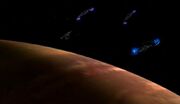Renegade54 (talk | contribs) m (+ bginfo, formatting) |
(Corrected two instances of nonstandard (erroneous) use of "comprise" by replacing such with standard "consisting.") |
||
| (One intermediate revision by one other user not shown) | |||
| Line 1: | Line 1: | ||
[[File:Class J gas giant.jpg|thumb|Several ships entering the atmosphere of a class J gas giant]] |
[[File:Class J gas giant.jpg|thumb|Several ships entering the atmosphere of a class J gas giant]] |
||
[[File:Defiant Starship Down.jpg|thumb|The USS ''Defiant'' in the atmosphere of a class J planet]] |
[[File:Defiant Starship Down.jpg|thumb|The USS ''Defiant'' in the atmosphere of a class J planet]] |
||
| − | In the [[Federation]] standard system of [[planetary classification]], a '''class J''' [[planet]] |
+ | In the [[Federation]] standard system of [[planetary classification]], a '''class J''' [[planet]] was a [[gas giant]]. |
In [[2372]], the {{USS|Defiant|2370}} entered the [[atmosphere]] of a class J planet to rescue the crew of a [[Karemma]] ship. The Karemma were attempting to escape from two [[Jem'Hadar]] [[Jem'Hadar attack ship|ships]]. The atmosphere had windspeeds of over 10,000 [[kilometers per hour]]. This planet also had [[fluorine]] gas in its atmosphere. ({{DS9|Starship Down}}) |
In [[2372]], the {{USS|Defiant|2370}} entered the [[atmosphere]] of a class J planet to rescue the crew of a [[Karemma]] ship. The Karemma were attempting to escape from two [[Jem'Hadar]] [[Jem'Hadar attack ship|ships]]. The atmosphere had windspeeds of over 10,000 [[kilometers per hour]]. This planet also had [[fluorine]] gas in its atmosphere. ({{DS9|Starship Down}}) |
||
| − | {{bginfo|According to [[Geoffrey Mandel]]'s ''[[Star Trek: Star Charts]]'', gas giants have an age ranging from two to ten billion years and a diameter between 50,000 and 140,000 kilometers. They are located within the "cold zone" of a [[star system]]. A class J planet is characterized by a tenuous surface, |
+ | {{bginfo|According to [[Geoffrey Mandel]]'s ''[[Star Trek: Star Charts]]'', gas giants have an age ranging from two to ten billion years and a diameter between 50,000 and 140,000 kilometers. They are located within the "cold zone" of a [[star system]]. A class J planet is characterized by a tenuous surface, consisting of [[gas]]eous [[hydrogen]] and some hydrogen compounds, and an [[atmosphere]] consisting of zones that vary in temperature and composition. The only known [[lifeform]]s to be found on J-class planets are [[hydrocarbon]]-based. Examples of class J planets include [[Jupiter]] and [[Saturn]]. }} |
{{Planetary classification}} |
{{Planetary classification}} |
||
| ⚫ | |||
| ⚫ | |||
[[de:Klasse J]] |
[[de:Klasse J]] |
||
[[ja:Jクラス]] |
[[ja:Jクラス]] |
||
[[nl:Klasse J planeet]] |
[[nl:Klasse J planeet]] |
||
| ⚫ | |||
| ⚫ | |||
Revision as of 00:05, 12 February 2014

Several ships entering the atmosphere of a class J gas giant
The USS Defiant in the atmosphere of a class J planet
In the Federation standard system of planetary classification, a class J planet was a gas giant.
In 2372, the USS Defiant entered the atmosphere of a class J planet to rescue the crew of a Karemma ship. The Karemma were attempting to escape from two Jem'Hadar ships. The atmosphere had windspeeds of over 10,000 kilometers per hour. This planet also had fluorine gas in its atmosphere. (DS9: "Starship Down")
According to Geoffrey Mandel's Star Trek: Star Charts, gas giants have an age ranging from two to ten billion years and a diameter between 50,000 and 140,000 kilometers. They are located within the "cold zone" of a star system. A class J planet is characterized by a tenuous surface, consisting of gaseous hydrogen and some hydrogen compounds, and an atmosphere consisting of zones that vary in temperature and composition. The only known lifeforms to be found on J-class planets are hydrocarbon-based. Examples of class J planets include Jupiter and Saturn.
| Planetary classification |
|---|
| B • D • G • H • J • K • L • M • N • R • T • Y • Other classes |
